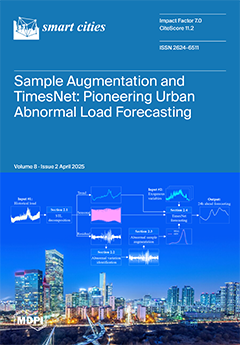Unmanned Aerial Vehicles (UAVs) are integral to the development of smart city infrastructures, enabling essential services such as real-time surveillance, urban traffic regulation, and cooperative environmental monitoring. UAV-to-UAV communication networks, despite their adaptability, have significant limits stemming from onboard battery constraints, inclement weather,
[...] Read more.
Unmanned Aerial Vehicles (UAVs) are integral to the development of smart city infrastructures, enabling essential services such as real-time surveillance, urban traffic regulation, and cooperative environmental monitoring. UAV-to-UAV communication networks, despite their adaptability, have significant limits stemming from onboard battery constraints, inclement weather, and variable flight trajectories. This work presents a thorough examination of energy and spectral efficiency in UAV-to-UAV communication over four frequency bands: 2.4 GHz, 5.8 GHz, 28 GHz, and 60 GHz. Our MATLAB R2023a simulations include classical free-space path loss, Rayleigh/Rician fading, and real-time mobility profiles, accommodating varied heights (up to 500 m), flight velocities (reaching 15 m/s), and fluctuations in the path loss exponent. Low-frequency bands (e.g., 2.4 GHz) exhibit up to 50% reduced path loss compared to higher mmWave bands for distances exceeding several hundred meters. Energy efficiency (
) is evaluated by contrasting throughput with total power consumption, indicating that 2.4 GHz initiates at around 0.15 bits/Joule (decreasing to 0.02 bits/Joule after 10 s), whereas 28 GHz and 60 GHz demonstrate markedly worse
(as low as
–
), resulting from increased path loss and oxygen absorption. Similarly, sub-6 GHz spectral efficiency can attain
in near-line-of-sight scenarios, whereas 60 GHz lines encounter significant attenuation at distances above 200–300 m without sophisticated beamforming techniques. Polynomial-fitting methods indicate that the projected
diverges from actual performance by less than 5% after 10 s of flight, highlighting the feasibility of machine-learning-based techniques for real-time power regulation, beam steering, or multi-band switching. While mmWave UAV communication can provide significant capacity enhancements (100–500 MHz bandwidth), energy efficiency deteriorates markedly without meticulous flight planning or adaptive protocols. We thus advocate using multi-band radios, adaptive modulation, and trajectory optimisation to equilibrate power consumption, ensure connection stability, and meet high data-rate requirements in densely populated, dynamic urban settings.
Full article





